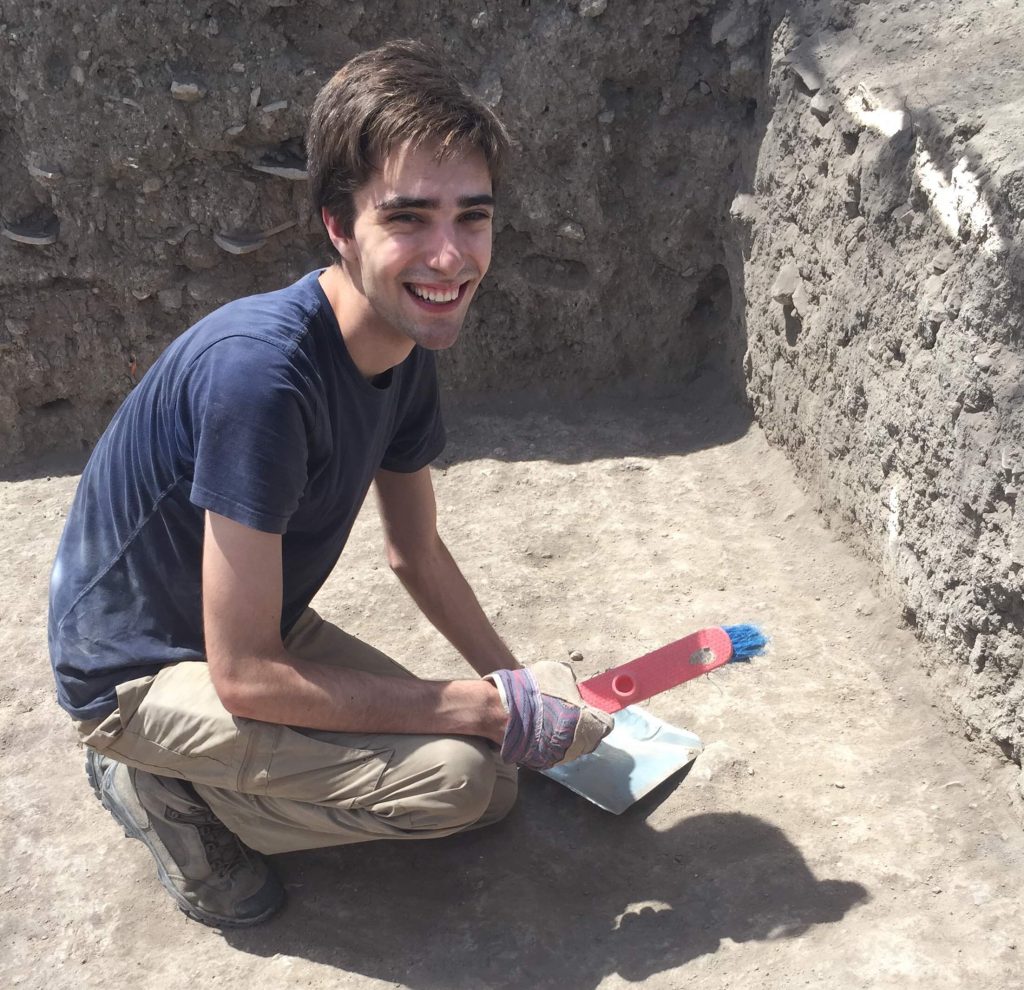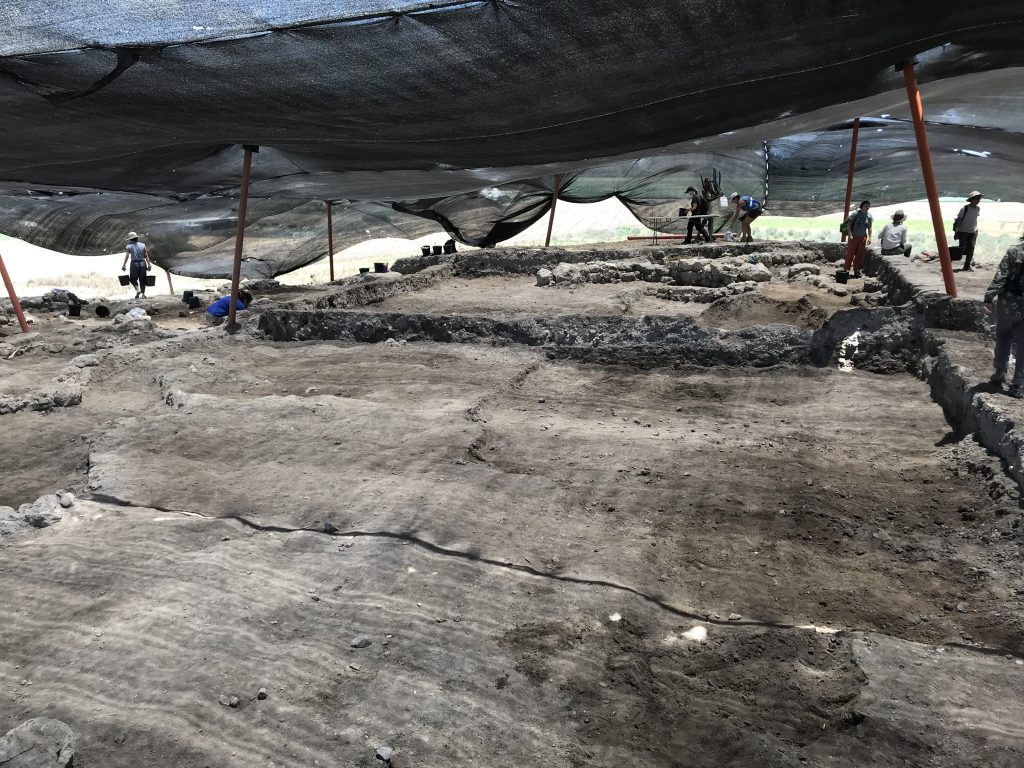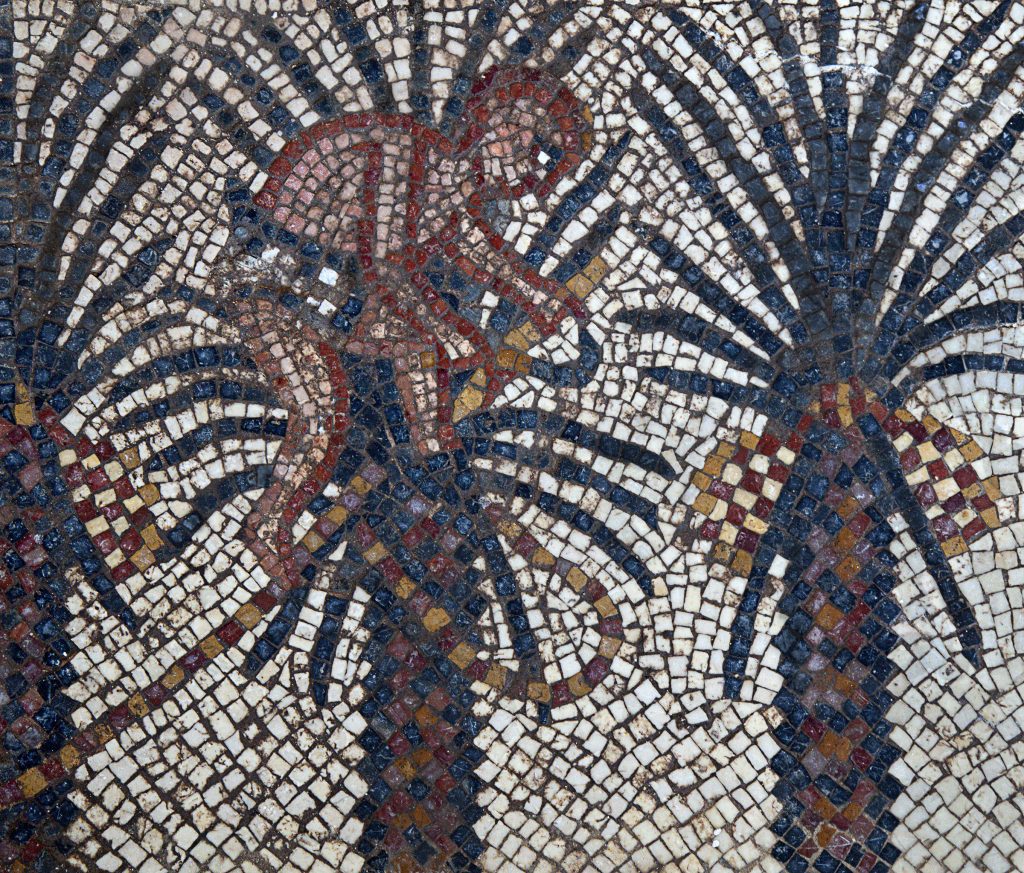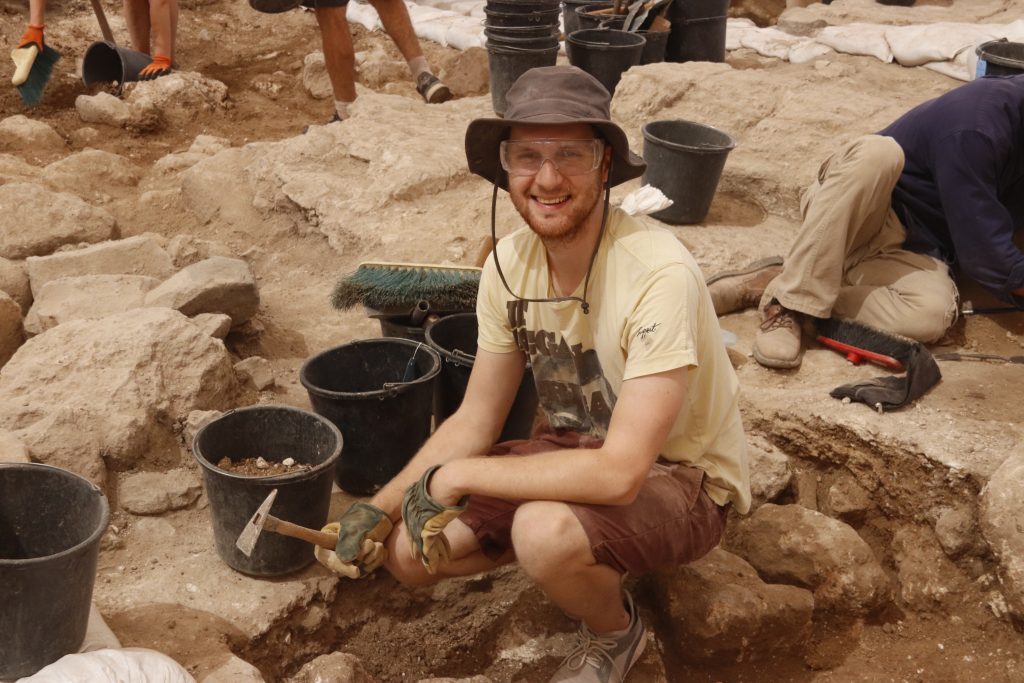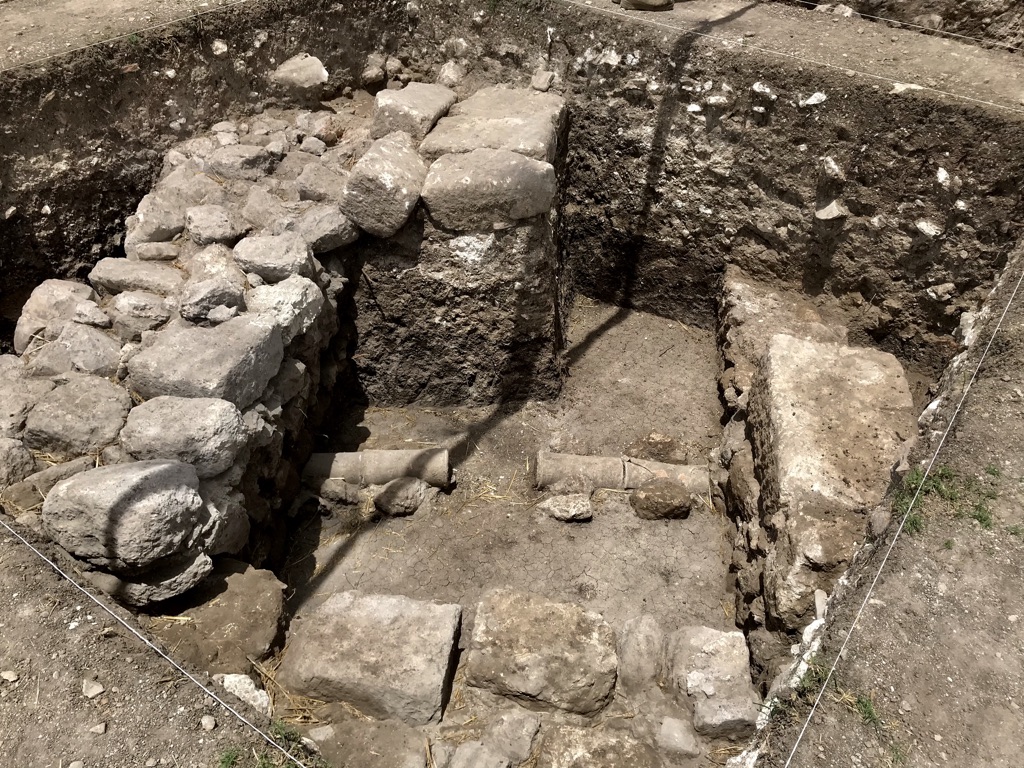Jacob Deans, University of Cambridge
With the generous support of the Anglo-Israel Archaeological Society’s Shelia and Anthony Rabin Grant, I was able to take part in the University of Chicago’s excavations at Tell Keisan (or Tel Kison in Hebrew), directed by David Schloen (University of Chicago), Gunnar Lehman (Ben Gurion of the Negev) and Liz Bloch-Smith (Princeton Theological Seminary).
Tell Keisan, situated in the Galilee, has evidence of habitation stretching from the Neolithic period right through to an outpost built by Saladin during the Crusader period. This season, however, the excavation focused on Area E — a Phoenician site dating from the early Bronze Age through to the Persian Period — while an adjunct group excavated the remains of a neighbouring Byzantine church in Area A.
This Phoenician site, while not as large or prosperous as others further north, was likely a trading outpost of relative importance, linking together the northern Levantine city states with the various emergent polities in the south — including, perhaps, the kingdom of Israel during the Iron Age. The directors of the dig tended to have a predilection for the High Chronology, so evidence of trade, economic development and so forth in Iron Age I seemed to be viewed by some of those on the dig in the context of the formation of a nearby Israelite state in the 10th century BCE.
Accordingly, the primary aim of the dig (at least from the perspective of the volunteers) was to work down from Persian-period to Iron II and Iron I strata. Because of this, in the square I was assigned to, we initially worked on a possible refuse pit from the Persian Period, so one had to attentively look for evidence of the pit line while stripping away layers — changes in soil colour and density, the size and regularity of ceramic finds, hints of stratification — all while sectioning the bulkhead at the side of the square. As time went on, I had the opportunity to rotate between a number of different tasks, attend lectures and field trips, and travel around the country.
This was my first taste of the practical side of archaeology (being a Theology undergraduate), so I felt like I came away from the dig season with a few insights I wouldn’t have gained elsewhere. I was impressed by the highly rigorous data collection at the site, aided in part by the use of OCHRE (Online Cultural and Historical Research Environment), a data management tool developed at the University of Chicago (see https://voices.uchicago.edu/ochre/). But what also intrigued me was the process of interpretation of finds on-site — whether field readings of pottery (usually done by the inimitable Gunnar Lehman), or simply the process of making observations yourself and relaying them to one’s square supervisor. In this sense, one was constantly interpreting as well as recording data. The way in which the discipline sits between the sciences and the humanities is not something that non-archaeologists always give due thought to when dealing with archaeological data, so it was interesting for me — someone with no prior experience — to gain that particular insight. I would like to thank the AIAS for their financial support, and all those from the University of Chicago for what was a memorable and highly edifying month.
Dominik Hronec, Kings College London
The summer of 2019 marked the ninth season of the Huqoq excavation project led by professor Jodi Magness from The University of North Carolina at Chapel Hill. Thanks to a generous contribution by the AIAS and encouragement from my professor (Joan Taylor from KCL), I was able to participate as a student volunteer at the Huqoq archaeological site under the supervision of an assistant director Shua Kisilevitz.
The Sunday to Friday daily routine started at 4 am when we woke up and walked from the nearby kibbutz to the site at 4:30 am. We would start digging at 5 am and finish at around noon. After the dig we would wash the daily findings and have a lecture, workshop or go on a field trip organised by the researchers in a particular area of expertise from our Huqoq staff.
The excavation of a Jewish village at Huqoq uncovered its 5th century CE Late Roman synagogue with unique figurative floor mosaics depicting both biblical and non-biblical scenes. The 2019 season uncovered two new mosaics. One of these is the depiction of four beasts from the Book of Daniel, chapter 7. The other is the depiction of a short passage from the Exodus 15:27 showing the episode of Elim. The Elim passage was identified after unearthing the inscription — ‘And they came to Elim’.
What I realised very early on was that the excavation at Huqoq was not only about the mosaics that make the headlines. Yes, they are the most significant findings in Huqoq, but it is not up to the archaeologists to decide what is important and what is not. The role of the archaeologists is to uncover and document everything from the latest to earliest activity at the site for any later academic purposes. Over the course of 16 centuries, different communities have inhabited the Huqoq village: expanding the synagogue building and adding new layers on top of the synagogue building up until the 20th century. In order to reach the floor level of the 5th-century synagogue, the team of nearly 50 students and staff members travelled back in time by carefully uncovering stratum after stratum, century after century.
I was assigned to excavate the south side, located outside the synagogue, which covered the area in front of the synagogue’s main entrance. Our group of four, excavated two squares dating from the 18th century back to medieval period. Every day, digging was marked by the findings of various fragments such as pottery, animal bones, glass, tesserae, coins, metal and charcoal. The most significant finding unearthed in our first square located at the farthest side of the site was a medieval water channel that filled the cistern with rainwater. The second square that we excavated was located next to the synagogue’s threshold. Our stratum was a medieval building extension to the synagogue, built around the above-mentioned cistern and the synagogue courtyard. In the corner of the medieval room, our team discovered a byzantine assemblage, consisting of chandelier fragments in the form of glass oil lamps, chains, lamp and wick holders. Due to the delicacy of the material, the excavation required a very careful and subtle procedure and it took us several days to fully uncover all the chandelier fragments.
The unforgettable one-month archaeological experience in Huqoq has encouraged me to apply for the next season and consider undertaking a PhD in Bible and Archaeology.
Lily Nash, University of Durham
This past summer saw the third season of excavations at the legionary base of Roman Legion VI Ferrata in northern Israel, near to the biblical site of Megiddo. They were conducted by the Jezreel Valley Regional Project (JVRP) and directed by Matthew J. Adams, Yotam Tepper, and Susan Cohen. The JVRP is a long-term, multi-disciplinary survey and excavation project that aims to investigate the history of human activity in the Jezreel Valley from the Palaeolithic through to the Ottoman period. Excavation at the legionary base of Legion VI Ferrata provides an important window into life in this region during the Roman period.
Established in the reign of the Emperor Hadrian during the early 2nd century CE, the legion’s base utilised its strategic position at the entranceof the Jezreel Valley to monitor the traffic passing through the region to Galilee and the inland valleys of northern Palestine. In this capacity, the legionary base had crucial access to important centres for the local —– and occasionally rebellious — Jewish population. So far, excavation at the site has revealed clear ties to major political and cultural events in the formative years of Rabbinic Judaism and Christianity and has provided an incredible new window into the nature and function of Roman military occupation in the eastern Roman provinces.
This year, excavation was focused in two areas of the legion’s principia (legionary headquarters compound). Area B was located in the rear cultic space (sacellum), in which the all-important legionary standards and the treasury would have been housed. The discovery of monumental architecture and large blocks of worked stone during the course of fieldwork provided further confirmation that the structure in question was indeed the base’s sacellum. Area C was situated in the street-facing corner of the principia in the hope that excavators would uncover the remains of a sewer system and the outer wall of the compound. Indeed, a significant water system and extensive piping was revealed.
I excavated for the most part in Area C under the supervision of Paul Flesher and Robin Knauth. In the nine squares that we opened over the course of the season, we found significant architectural remains. These finds included large stone building blocks, a column fragment, and layers of floor substructure that covered the remains of a drainage system. Other exciting finds consisted of an unanticipated quantity of coins and a stamped roof tile that provided further confirmation that our site was indeed the base utilised by VI Ferrata Legion. Over the course of the excavation I learnt a great deal about fieldwork methods and recording, adding much to my previously basic skill set. In particular, I was very interested in the use of photogrammetry and GIS software in the recording process and was able to observe and assist with this aspect of the recording, developing technological skills that I will be able to utilise in my upcoming Honours project at the University of Melbourne in 2020.
Alex Rodzinka, Institute of Archaeology, UCL

Thanks to the grant from AIAS I was able to take part in Tel Yaqush Research and Excavation Project in Jordan Valley, Israel. It was my second season at Tel Yaqush so it was exciting to come back and explore the site a bit more as well as meet a few familiar faces. Tel Yaqush is an Early Bronze Age settlement where, in different phases of occupation, two communities can be distinguished, local, and that of Khirbet Kerak, which is widely believed to originate from Transcaucasia. Interestingly, it is a sister site of Tel Beth Yerah, where I had the privilege of working in 2015, my first excavation in Israel. That is the reason for naming the whole culture and the specific type of pottery they produced, after Khirbet Kerak. This provided a satisfying continuity to my excavations in Israel.
The current project is in a way a continuation of work that had been done at the site over 20 years ago when the team from the University of Chicago first started excavating there. This year I worked exclusively on re-excavating a square opened in the early 2000s in the area BM, which was especially challenging as we were dealing with the documentation left by the previous researchers and with the choices that they had made regarding excavating the area. Another task was deciding what was actually in situ and what was the result of more recent conditions affecting the square, because it had been exposed for two decades. We were dealing with multiple walls and pavements, mostly from Early Bronze I. Certain parts of the square remained much higher than the rest for no apparent reason and we began by removing them as they only caused confusion. It was satisfying to see the walls connect as we exposed them further, noting what the previous excavators had missed. I think I learned a lot from fellow students, especially when it comes to distinguishing the differences in the soil colour and recognising the elusive mudbricks in sections. Less intellectually stimulating were countless hours spent on washing pottery late into the evening, but they gave us the chance to talk about our many interests outside of archaeology. To me the most interesting and eye-opening were conversations with my Israeli friend who has worked on many excavations in this country, big and fast-paced, led by Israeli teams and just so different from the digs I have been a part of. It gives one perspective and appreciation for archaeology well done.
Rebekah Welton, University of Exeter

Thanks to the very generous Slope Award offered to me by the AIAS I was able to spend three weeks excavating on Mount Zion in Jerusalem in the summer of 2019. I had recently graduated from my PhD programme and wanted to continue with my archaeological work in Jerusalem beyond the end of my doctorate. Having already excavated on Mount Zion under the directorship of Rafi Lewis and Shimon Gibson for five seasons I was eager to return and be a part of this unfolding and increasingly exciting site.
As an Area Supervisor I oversaw the excavations of the northern area of the site in which we came down onto structural remains dating from the Late Byzantine, Early Byzantine and Early Roman periods. I also excavated an in-situ tabun (bread oven) base which indicated a floor level. Unfortunately, much of the floor adjacent to the tabun base was no longer intact, having been cut through by later builders. As I continued to oversee the excavation below this level, we eventually came down onto bedrock in which a square shaped cavity had been cut. I look forwarded to excavating this cavity in a later season.
In the southern area of the site we made some finds of major significance. In the remains of a ruined house we uncovered arrowheads, crosses and gold jewellery from a stratum dating from the 11th century CE. We surmise that these finds relate to the Crusader attack on Jerusalem in July 1099 as we have also identified the 17 m wide and 4 m deep ditch which abutted the Fatimid city wall. This ditch was sealed with a burnt layer containing coins dating to the time of King Baldwin III who, during a later civil war in 1153, burnt much of the city. One piece of jewellery, likely used for fastening a headscarf or other clothing, is simply breath-taking. It is constructed of gold in an Egyptian style and decorated with pearls and other semi-precious stones – blue, green and turquoise in colour.
Another significant stratum dating to the Iron Age contained not only Iron Age potsherds but also Scythian type bronze and iron arrowheads amongst burnt wood and ash layers. Such a stratum and its finds may corroborate the reported Babylonian attack on Jerusalem in 586/587 BCE, making this discovery particularly pertinent for my own research interests which relate to the material culture of Iron Age Israel and Judah. Another piece of jewellery was found here, this time from the Iron Age. It was made of gold and silver and appears to be fashioned into the shape of a bunch of grapes held from a clasp. This earring or garment tassel was likely lost during the action of the attack and buried until its excavation some 2600 years later. Considering that jewellery is normally looted and melted down, the discovery of both these gold pieces of ornamentation is exciting because it provides us with a glimpse into the daily lives of people involved in these momentous historical events.
As anticipated, my time excavating in Jerusalem was both enjoyable and thoroughly enriching for my understanding of material culture and the methods by which it is uncovered. I am privileged to be a part of such a unique and fascinating project and am once again grateful for the support of the AIAS in my continued involvement.


